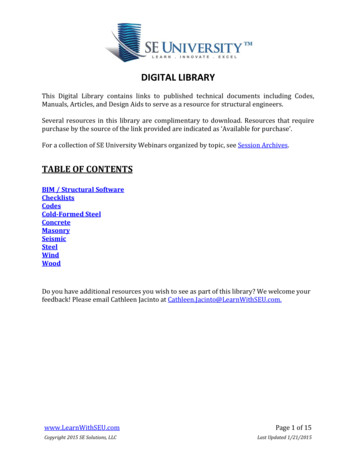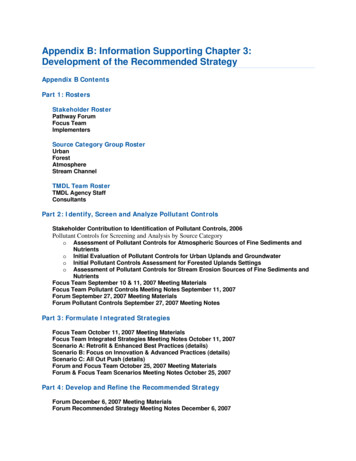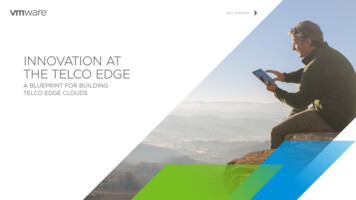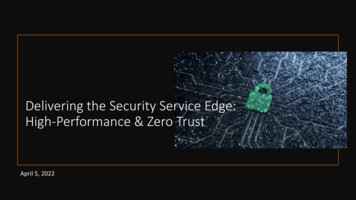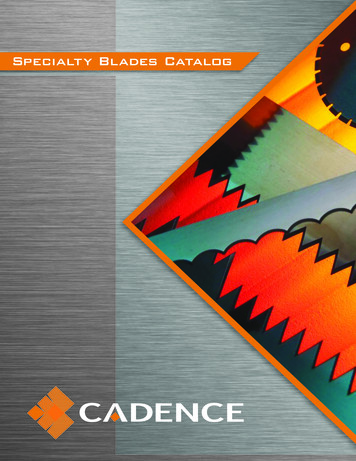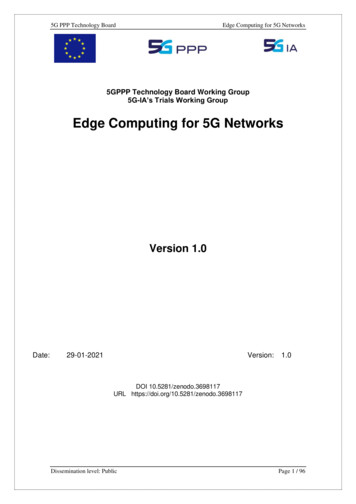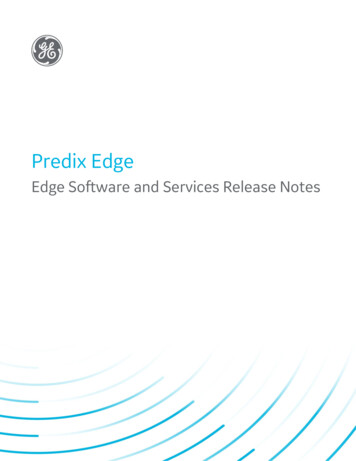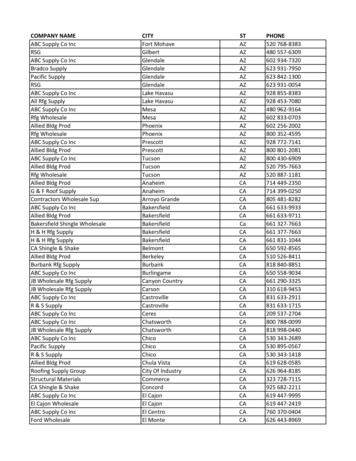
Transcription
EDGE 530 Owner’s Manual
2019 Garmin Ltd. or its subsidiariesAll rights reserved. Under the copyright laws, this manual may not be copied, in whole or in part, without the written consent of Garmin. Garmin reserves the right to change or improve itsproducts and to make changes in the content of this manual without obligation to notify any person or organization of such changes or improvements. Go to www.garmin.com for current updatesand supplemental information concerning the use of this product.Garmin , the Garmin logo, ANT , Auto Lap , Auto Pause , Edge , Forerunner , inReach , and Virtual Partner are trademarks of Garmin Ltd. or its subsidiaries, registered in the USA and othercountries. Connect IQ , Garmin Connect , Garmin Express , Varia , Varia Vision , and Vector are trademarks of Garmin Ltd. or its subsidiaries. These trademarks may not be used withoutthe express permission of Garmin. Android is a trademark of Google Inc. Apple and Mac are trademarks of Apple, Inc., registered in the U.S. and other countries. The BLUETOOTH word mark and logos are owned by theBluetooth SIG, Inc. and any use of such marks by Garmin is under license. The Cooper Institute , as well as any related trademarks, are the property of The Cooper Institute. Advanced heartbeatanalytics by Firstbeat. Di2 and Shimano STEPS are trademarks of Shimano, Inc. Shimano is a registered trademark of Shimano, Inc. Training Stress Score (TSS), Intensity Factor (IF), andNormalized Power (NP) are trademarks of Peaksware, LLC. STRAVA and Strava are trademarks of Strava, Inc. Wi‑Fi is a registered trademark of Wi-Fi Alliance Corporation. Windows is aregistered trademark of Microsoft Corporation in the United States and other countries. Other trademarks and trade names are those of their respective owners. This product is ANT certified. Visit www.thisisant.com/directory for a list of compatible products and apps. M/N: A03485
Table of ContentsIntroduction.1Device Overview . 1Viewing the Status Page . 1Viewing Widgets . 1Using the Shortcut Menu . 1Pairing Your Smartphone . 1Charging the Device . 1About the Battery . 2Installing the Standard Mount . 2Installing the Out-Front Mount . 2Releasing the Edge .2Installing the Mountain Bike Mount . 2Acquiring Satellite Signals . 3Training. 3Going for a Ride .3Segments .3Strava Segments . 3Using the Strava Segment Explore Widget . 4Following a Segment From Garmin Connect . 4Enabling Segments . 4Racing a Segment . 4Viewing Segment Details . 4Segment Options . 4Deleting a Segment . 4Workouts .4Following a Workout From Garmin Connect . 4Starting a Workout . 4Stopping a Workout . 5Deleting Workouts .5About the Training Calendar . 5Using Garmin Connect Training Plans . 5Interval Workouts . 5Creating an Interval Workout . 5Starting an Interval Workout . 5Training Indoors . 5Pairing Your ANT Indoor Trainer . 5Using an ANT Indoor Trainer . 5Setting Resistance . 5Setting Target Power . 5Setting a Training Target . 6Cancelling a Training Target . 6My Stats . 6Performance Measurements . 6Training Status . 6About VO2 Max. Estimates . 6Getting Your VO2 Max. Estimate . 7Tips for Cycling VO2 Max. Estimates . 7Heat and Altitude Performance Acclimation . 7Training Load . 7Getting Your Training Load Estimate . 7Training Load Focus . 7About Training Effect . 8Recovery Time . 8Viewing Your Recovery Time . 8Getting Your FTP Estimate . 8Conducting an FTP Test . 8Automatically Calculating FTP . 9Viewing Your Stress Score . 9Turning Off Performance Notifications . 9Viewing Your Power Curve . 9Syncing Activities and Performance Measurements . 9Personal Records . 9Viewing Your Personal Records . 9Table of ContentsReverting a Personal Record . 9Deleting a Personal Record . 9Training Zones . 9Navigation . 9Locations . 9Marking Your Location . 9Saving Locations from the Map . 9Navigating to a Location . 9Navigating Back to Start . 10Stopping Navigation . 10Editing Locations .10Deleting a Location . 10Projecting a Location . 10Courses . 10Creating a Course on Your Device . 10Following a Course From Garmin Connect . 10Tips for Riding a Course . 10Viewing Course Details . 10Displaying a Course on the Map . 10Using ClimbPro . 11Course Options . 11Stopping a Course . 11Deleting a Course . 11Trailforks Routes . 11Map Settings . 11Browsing the Map . 11Changing the Map Orientation . 11Route Settings . 11Selecting an Activity for Route Calculation . 11Connected Features . 11Bluetooth Connected Features . 11Incident Detection and Assistance Features . 12Incident Detection . 12Assistance . 12Adding Emergency Contacts .12Viewing Your Emergency Contacts . 12Requesting Assistance .12Turning Incident Detection On and Off . 12Cancelling an Automated Message . 12Sending a Status Update After an Incident . 12Starting a GroupTrack Session . 13Tips for GroupTrack Sessions .13Setting the Bike Alarm . 13Playing Audio Prompts on Your Smartphone . 13Transferring Files to Another Edge Device . 13Wi‑Fi Connected Features . 13Setting Up Wi‑Fi Connectivity . 13Wi‑Fi Settings .13Wireless Sensors . 14Putting On the Heart Rate Monitor . 14Setting Your Heart Rate Zones . 14About Heart Rate Zones . 14Fitness Goals . 14Tips for Erratic Heart Rate Data .14Installing the Speed Sensor . 14Installing the Cadence Sensor . 15About the Speed and Cadence Sensors . 15Data Averaging for Cadence or Power . 15Pairing Your Wireless Sensors . 15Training with Power Meters . 15Setting Your Power Zones . 15Calibrating Your Power Meter . 15Pedal-Based Power . 16Cycling Dynamics . 16Using Cycling Dynamics . 16i
Updating the Vector Software Using the Edge Device . 16Situational Awareness . 16Using Electronic Shifters .16Using an eBike .16Viewing eBike Sensor Details . 16inReach Remote . 16Using the inReach Remote . 16Device Care . 22Cleaning the Device . 22Caring for the Heart Rate Monitor . 22User Replaceable Batteries . 22Replacing the Heart Rate Monitor Battery . 22Replacing the Speed Sensor Battery . 22Replacing the Cadence Sensor Battery . 23History . 17Troubleshooting. 23Viewing Your Ride . 17Viewing Your Time in Each Training Zone . 17Deleting Rides .17Viewing Data Totals . 17Deleting Data Totals . 17Garmin Connect .17Sending Your Ride to Garmin Connect . 17Data Recording . 17Data Management . 17Connecting the Device to Your Computer . 17Transferring Files to Your Device . 17Deleting Files . 18Disconnecting the USB Cable .18Resetting the Device .23Restoring the Default Settings . 23Clearing User Data and Settings . 23Maximizing Battery Life .23Turning On Battery Save Mode . 23My phone will not connect to the device . 23Improving GPS Satellite Reception . 23My device is in the wrong language . 23Setting Your Elevation . 24Calibrating the Compass . 24Temperature Readings . 24Replacement O-rings . 24Getting More Information . 24Customizing Your Device . 18Appendix . 24Connect IQ Downloadable Features . 18Downloading Connect IQ Features Using Your Computer . 18Profiles . 18Setting Up Your User Profile . 18About Training Settings . 18Updating Your Activity Profile . 18Adding a Data Screen . 19Editing a Data Screen . 19Rearranging Data Screens . 19Alerts . 19Setting Range Alerts . 19Setting Recurring Alerts . 19Setting Smart Eat and Drink Alerts . 19Auto Lap .19Marking Laps by Position . 19Marking Laps by Distance . 20Using Auto Sleep . 20Using Auto Pause . 20Using Auto Scroll . 20Starting the Timer Automatically . 20Changing the Satellite Setting . 20Phone Settings . 20System Settings . 20Display Settings . 20Using the Backlight . 21Customizing the Widget Loop . 21Data Recording Settings . 21Changing the Units of Measure . 21Turning the Device Tones On and Off . 21Changing the Device Language . 21Time Zones . 21Setting Up Extended Display Mode . 21Exiting Extended Display Mode . 21Data Fields .24VO2 Max. Standard Ratings . 26FTP Ratings . 27Heart Rate Zone Calculations .27Wheel Size and Circumference . 27Index . 28Device Information . 21Product Updates . 21Updating the Software Using the Garmin Connect App . 21Updating the Software Using Garmin Express . 21Specifications .21Edge Specifications . 21Heart Rate Monitor Specifications . 22Speed Sensor and Cadence Sensor Specifications . 22Viewing Device Information . 22Viewing Regulatory and Compliance Information . 22iiTable of Contents
IntroductionWARNINGSee the Important Safety and Product Information guide in theproduct box for product warnings and other importantinformation.Always consult your physician before you begin or modify anyexercise program.Device OverviewThe status page appears. A flashing icon means the device issearching for a signal. A solid icon means the signal wasfound or the sensor is connected.Viewing WidgetsYour device is preloaded with several widgets, and more areavailable when you pair your device with a smartphone or othercompatible device.1 From the status page, select Widgets.2 Select or to view more widgets.The next time you view the widgets, the last widget you viewedappears.Using the Shortcut MenuShortcut menu options are available to quickly access featuresor perform functions, such as editing the current activity profilefrom the home screen. Whenappears on the screen during a ride, selecttoview the shortcut menu options. When appears on the screen, holdto view the shortcutmenu options.Pairing Your SmartphoneNOTE: Go to www.buy.garmin.com to purchase optionalaccessories.To use the connected features of the Edge device, it must bepaired directly through the Garmin Connect app, instead offrom the Bluetooth settings on your smartphone.1 From the app store on your smartphone, install and open theGarmin Connect app.to turn on the device.2 HoldThe first time you turn on the device, you will select thedevice language. The next screen prompts you to pair withyour smartphone.TIP: You can select Menu Settings ConnectedFeatures Phone Pair Smartphone to manually enterpairing mode.3 Select an option to add your device to your Garmin Connectaccount: If this is the first device you have paired with the GarminConnect app, follow the on-screen instructions. If you have already paired another device with the Garminormenu, select GarminConnect app, from theDevices Add Device, and follow the on-screeninstructions.After you pair successfully, a message appears, and your devicesyncs automatically with your smartphone.Viewing the Status PageCharging the DeviceSelect to enter sleep mode and wake the device.Hold to turn the device on and off.Select to scroll through the data screens, options,and settings.From the home screen, select to view the statuspage.Select to scroll through the data screens, options,and settings.From the home screen, select to view the devicemenu.Select to mark a new lap.Select to start and stop the activity timer.Select to return to the previous screen.Hold to return to the home screen.Select to choose an option or to acknowledge amessage.During a ride, select to view menu options such asalerts and data fields.ElectricalcontactsCharge using an Edge external battery packaccessory.The status page displays the connection status of the GPS,wireless sensors, and your smartphone.Select an option: From the home screen, select . During a ride, select Status Page.Introduction NOTICETo prevent corrosion, thoroughly dry the USB port, the weathercap, and the surrounding area before charging or connecting toa computer.The device is powered by a built-in lithium-ion battery that youcan charge using a standard wall outlet or a USB port on yourcomputer.NOTE: The device will not charge when outside the approvedtemperature range (Edge Specifications, page 21).1 Pull up the weather cap from the USB port .1
Installing the Out-Front MountNOTE: If you do not have this mount, you can skip this task.1 Select a secure location to mount the Edge device where itdoes not interfere with the safe operation of your bike.2 Use the hex key to remove the screw from the handlebarconnector .2 Plug the small end of the USB cable into the USB port on thedevice.3 Plug the large end of the USB cable into an AC adapter or acomputer USB port.4 Plug the AC adapter into a standard wall outlet.When you connect the device to a power source, the deviceturns on.5 Charge the device completely.After you charge the device, close the weather cap.About the BatteryWARNINGThis device contains a lithium-ion battery. See the ImportantSafety and Product Information guide in the product box forproduct warnings and other important information.Installing the Standard MountFor the best GPS reception, position the bike mount so the frontof the device is oriented toward the sky. You can install the bikemount on the stem or the handlebars.1 Select a secure location to mount the device where it doesnot interfere with the safe operation of your bike.2 Place the rubber disk on the back of the bike mount.Two rubber disks are included, and you can select the diskthat best fits your bike. The rubber tabs align with the back ofthe bike mount so it stays in place.3 Place the rubber pad around the handlebar: If the handlebar diameter is 25.4 mm, use the thicker pad. If the handlebar diameter is 31.8 mm, use the thinner pad.4 Place the handlebar connector around the rubber pad.5 Replace and tighten the screw.NOTE: Garmin recommends tightening the screw so themount is secure, with a maximum torque specification of7 lbf-in. (0.8 N-m). You should check the tightness of thescrew periodically.6 Align the tabs on the back of the Edge device with the bikemount notches . 7 Press down slightly and turn the Edge device clockwise untilit locks into place.3 Place the bike mount on the bike stem.4 Attach the bike mount securely using the two bands .5 Align the tabs on the back of the device with the bike mountnotches .6 Press down slightly and turn the device clockwise until itlocks into place.2Releasing the Edge1 Turn the Edge clockwise to unlock the device.2 Lift the Edge off the mount.Installing the Mountain Bike MountNOTE: If you do not have this mount, you can skip this task.1 Select a secure location to mount the Edge device where itdoes not interfere with the safe operation of your bike.from thehandlebar connector .2 Use the 3 mm hex key to remove the screwIntroduction
Acquiring Satellite SignalsThe device may need a clear view of the sky to acquire satellitesignals. The time and date are set automatically based on theGPS position.1 Go outdoors to an open area.The front of the device should be oriented toward the sky.2 Wait while the device locates satellites.It may take 30–60 seconds to locate satellite signals.TrainingGoing for a Ride3 Select an option: If the handlebar diameter is 25.4 mm, place the thickerpad around the handlebar. If the handlebar diameter is 31.8 mm, place the thinnerpad around the handlebar. If the handlebar diameter is 35 mm, do not use a rubberpad.4 Place the handlebar connector around the handlebar, so thatthe mount arm is above the bike stem.5 Use the 3 mm hex key to loosen the screw on the mountarm, position the mount arm, and tighten the screw.NOTE: Garmin recommends tightening the screw so themount arm is secure, with a maximum torque specification of20 lbf-in. (2.26 N-m). You should check the tightness of thescrew periodically.If your device was packaged with a wireless sensor, they arealready paired and can be activated during initial setup.to turn on the device.1 HoldGooutside,and wait while the device locates satellites.2The satellite bars turn green when the device is ready.3 From the home screen, select .4 Select an activity profile.5 Select to start the activity timer.6786 If necessary, use the 2 mm hex key to remove the twoscrews on the back side of the mount , remove and rotatethe connector, and replace the screws to change theorientation of the mount.7 Replace and tighten the screw on the handlebar connector.NOTE: Garmin recommends tightening the screw so themount is secure, with a maximum torque specification of7 lbf-in. (0.8 N-m). You should check the tightness of thescrew periodically.8 Align the tabs on the back of the Edge device with the bikemount notches .9NOTE: History is recorded only while the activity timer isrunning.orfor additional data screens.Selectto view menu options such as alertsIf necessary, selectand data fields.to stop the activity timer.SelectTIP: Before you save this ride and share it on your GarminConnect account, you can change the ride type. Accurateride type data is important for creating bike friendly courses.Select Save Ride.SegmentsFollowing a segment: You can send segments from yourGarmin Connect account to your device. After a segment issaved to your device, you can follow the segment.NOTE: When you download a course from your GarminConnect account, all segments in the course are downloadedautomatically.Racing a segment: You can race a segment, trying to match orexceed your personal record or other cyclists who haveridden the segment.Strava Segments9 Press down slightly and turn the Edge device clockwise untilit locks into place.TrainingYou can download Strava segments to your Edge 530 device.Follow Strava segments to compare your performance with yourpast rides, friends, and pros who have ridden the samesegment.To sign up for a Strava membership, go to the segments widgetin your Garmin Connect account. For more information, go towww.strava.com.3
The information in this manual applies to both Garmin Connectsegments and Strava segments.Using the Strava Segment Explore WidgetThe Strava Segment Explore widget allows you to view and ridenearby Strava segments.From the Strava Segment Explore widget, select a segment.The segment appears on the map.Following a Segment From Garmin ConnectBefore you can download and follow a segment from GarminConnect, you must have a Garmin Connect account (GarminConnect, page 17).NOTE: If you are using Strava segments, your starred segmentsare transferred automatically to your device when it syncs withthe Garmin Connect app.1 Select an option: Open the Garmin Connect app. Go to connect.garmin.com.2 Select a segment.3 Select or Send to Device.4 Follow the on-screen instructions.5 On the Edge device, select Menu Training Segments.6 Select the segment.7 Select Ride.Enabling SegmentsYou can enable segment racing and prompts that alert you toapproaching segments.1 Select Menu Training Segments Segment Options Enable/Disable Edit Multiple.2 Select the segments to enable.NOTE: Prompt
2 Plug the small end of the USB cable into the USB port on the device. 3 Plug the large end of the USB cable into an AC adapter or a computer USB port. 4 Plug the AC adapter into a standard wall outlet. When you connect the device to a power source, the device turns on. 5 Charge the device completely. After you charge the device, close the weather cap.

